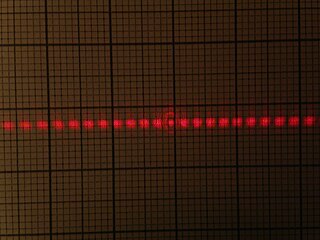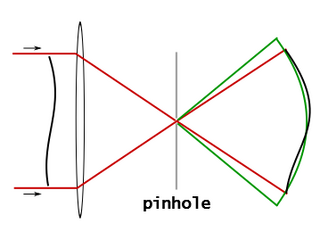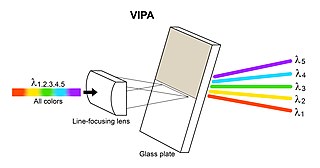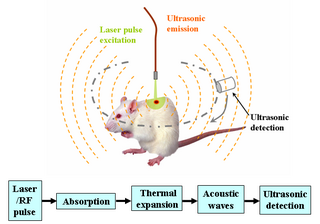This article needs additional citations for verification .(April 2024) |
An optical neural network (ONN) is a physical implementation of an artificial neural network with optical components.
This article needs additional citations for verification .(April 2024) |
An optical neural network (ONN) is a physical implementation of an artificial neural network with optical components.
Early ONNs used a photorefractive volume hologram to interconnect arrays of input neurons to arrays of output with synaptic weights in proportion to the multiplexed hologram's strength. [2] Volume holograms were further multiplexed using spectral hole burning to add one dimension of wavelength to space to achieve four dimensional interconnects of two dimensional arrays of neural inputs and outputs. [3] This led to research on alternative methods using the strength of the optical interconnect to implement neuronal communications. [4]
Silicon photonics offers superior speed, but lacks the massive parallelism that free-space optics can deliver.
Free-space optics offers substantial parallelism. One implementation used phase masks for a handwritten digit classifier. [5] Light passing through stacked 3D-printed phase masks can be read by a photodetector array of ten detectors, each representing a digit class (0 through 9). Although this network can achieve terahertz-speeds, it lacks flexibility, as the phase masks are fabricated for a specific task and cannot be trained.
An alternative method employs a 4F convolutional system. This system uses two lenses to execute the convolution Fourier transforms, enabling passive conversion into the Fourier domain without power consumption or latency. The convolution kernels are task-specific fixed phase masks. [6]
Another technique used kernel tiling to access the parallelism of the 4F system while using a digital micromirror device (DMD) instead of a phase mask. Kernels can be entered into the 4F system and conduct inference. [7]
Typical neural networks are not designed for the 4F systems, using a lower resolution and more channels in their feature maps.
The Programmable Optical Array/Analogic Computer (POAC) was implemented in 2000 based on a modified joint Fourier transform correlator (JTC) and bacteriorhodopsin (BR) as a holographic optical memory. The system offered full parallelism, large array size and the speed of light in an optical convolutional neural network. POAC is a general purpose and programmable array computer that has a wide range of applications including: image processing, pattern recognition, target tracking, real-time video processing, document security, and optical switching.
Taichi is a hybrid ONN that combines the power efficiency and parallelism of optical diffraction and the configurability of optical interference. Taichi offers 13.96 million parameters. Taichi avoids the high error rates that afflict deep (multi-layer) networks by combining clusters of fewer-layer diffractive units with arrays of interferometers for reconfigurable computation. Its encoding protocol divides large network models into sub-models that can be distributed across multiple chiplets in parallel. [8]
Taichi achieved 91.89% accuracy in tests with the Omniglot database. It was also used to generate music Bach and generate images the styles of Van Gogh and Munch. [8]
The developers claimed energy efficiency of up to 160 trillion operations second-1 watt-1 and an area efficiency of 880 trillion multiply-accumulate operations mm-2 or 103 more energy efficient than the NVIDIA H100, and 102 times more energy efficient and 10 times more area efficient than previous ONNs. [8]
ONNs include the Hopfield neural network [9] and the Kohonen self-organizing map with liquid crystal spatial light modulators. [10] Neuromorphic engineering can be used to create neuromorphic photonic systems. Typically, these systems encode information in the networks using spikes, mimicking the functionality of spiking neural networks in optical and photonic hardware.
Other photonic devices have demonstrated neuromorphic functionalities, including vertical-cavity surface-emitting lasers, [11] [12] integrated photonic modulators, [13] optoelectronic systems based on superconducting Josephson junctions [14] or systems based on resonant tunnelling diodes. [15]
Biological neural networks are electrochemical, while optical neural networks use electromagnetic waves. Optical interfaces to biological neural networks can be created with optogenetics. Biological neural networks use multiple mechanisms to change the state of the neurons. These include short-term and long-term synaptic plasticity. Synaptic plasticity is among the electrophysiological phenomena used to control the efficiency of synaptic transmission, long-term for learning and memory, and short-term for transient changes in synaptic transmission efficiency. Implementing this ideally requires advanced photonic materials.
Desirable properties in photonic materials for optical neural networks include the ability to change their efficiency of transmitting light, based on the intensity of incoming light.
Neuromorphic computing is an approach to computing that is inspired by the structure and function of the human brain. A neuromorphic computer/chip is any device that uses physical artificial neurons to do computations. In recent times, the term neuromorphic has been used to describe analog, digital, mixed-mode analog/digital VLSI, and software systems that implement models of neural systems. The implementation of neuromorphic computing on the hardware level can be realized by oxide-based memristors, spintronic memories, threshold switches, transistors, among others. Training software-based neuromorphic systems of spiking neural networks can be achieved using error backpropagation, e.g., using Python based frameworks such as snnTorch, or using canonical learning rules from the biological learning literature, e.g., using BindsNet.
Holonomic brain theory is a branch of neuroscience investigating the idea that human consciousness is formed by quantum effects in or between brain cells. Holonomic refers to representations in a Hilbert phase space defined by both spectral and space-time coordinates. Holonomic brain theory is opposed by traditional neuroscience, which investigates the brain's behavior by looking at patterns of neurons and the surrounding chemistry.
Optical computing or photonic computing uses light waves produced by lasers or incoherent sources for data processing, data storage or data communication for computing. For decades, photons have shown promise to enable a higher bandwidth than the electrons used in conventional computers.

An optical vortex is a zero of an optical field; a point of zero intensity. The term is also used to describe a beam of light that has such a zero in it. The study of these phenomena is known as singular optics.

Extraordinary optical transmission (EOT) is the phenomenon of greatly enhanced transmission of light through a subwavelength aperture in an otherwise opaque metallic film which has been patterned with a regularly repeating periodic structure. Generally when light of a certain wavelength falls on a subwavelength aperture, it is diffracted isotropically in all directions evenly, with minimal far-field transmission. This is the understanding from classical aperture theory as described by Bethe. In EOT however, the regularly repeating structure enables much higher transmission efficiency to occur, up to several orders of magnitude greater than that predicted by classical aperture theory. It was first described in 1998.
Digital holography is the acquisition and processing of holograms with a digital sensor array, typically a CCD camera or a similar device. Image rendering, or reconstruction of object data is performed numerically from digitized interferograms. Digital holography offers a means of measuring optical phase data and typically delivers three-dimensional surface or optical thickness images. Several recording and processing schemes have been developed to assess optical wave characteristics such as amplitude, phase, and polarization state, which make digital holography a very powerful method for metrology applications .
Phased-array optics is the technology of controlling the phase and amplitude of light waves transmitting, reflecting, or captured (received) by a two-dimensional surface using adjustable surface elements. An optical phased array (OPA) is the optical analog of a radio-wave phased array. By dynamically controlling the optical properties of a surface on a microscopic scale, it is possible to steer the direction of light beams, or the view direction of sensors, without any moving parts. Phased-array beam steering is used for optical switching and multiplexing in optoelectronic devices and for aiming laser beams on a macroscopic scale.
Computer-generated holography (CGH) is a technique that uses computer algorithms to generate holograms. It involves generating holographic interference patterns. A computer-generated hologram can be displayed on a dynamic holographic display, or it can be printed onto a mask or film using lithography. When a hologram is printed onto a mask or film, it is then illuminated by a coherent light source to display the holographic images.

Spiking neural networks (SNNs) are artificial neural networks (ANN) that more closely mimic natural neural networks. In addition to neuronal and synaptic state, SNNs incorporate the concept of time into their operating model. The idea is that neurons in the SNN do not transmit information at each propagation cycle, but rather transmit information only when a membrane potential—an intrinsic quality of the neuron related to its membrane electrical charge—reaches a specific value, called the threshold. When the membrane potential reaches the threshold, the neuron fires, and generates a signal that travels to other neurons which, in turn, increase or decrease their potentials in response to this signal. A neuron model that fires at the moment of threshold crossing is also called a spiking neuron model.

A point diffraction interferometer (PDI) is a type of common-path interferometer. Unlike an amplitude-splitting interferometer, such as a Michelson interferometer, which separates out an unaberrated beam and interferes this with the test beam, a common-path interferometer generates its own reference beam. In PDI systems, the test and reference beams travel the same or almost the same path. This design makes the PDI extremely useful when environmental isolation is not possible or a reduction in the number of precision optics is required. The reference beam is created from a portion of the test beam by diffraction from a small pinhole in a semitransparent coating. The principle of a PDI is shown in Figure 1.

A microlens is a small lens, generally with a diameter less than a millimetre (mm) and often as small as 10 micrometres (μm). The small sizes of the lenses means that a simple design can give good optical quality but sometimes unwanted effects arise due to optical diffraction at the small features. A typical microlens may be a single element with one plane surface and one spherical convex surface to refract the light. Because micro-lenses are so small, the substrate that supports them is usually thicker than the lens and this has to be taken into account in the design. More sophisticated lenses may use aspherical surfaces and others may use several layers of optical material to achieve their design performance.
A holographic optical element (HOE) is an optical component (mirror, lens, directional diffuser, etc.) that produces holographic images using principles of diffraction. HOE is most commonly used in transparent displays, 3D imaging, and certain scanning technologies.
Demetri Psaltis is a Greek-American electrical engineer who was the Dean of the School of Engineering at École Polytechnique Fédérale de Lausanne from 2007 to 2017. Since 2024 he is a professor emeritus at EPFL. He is one of the founders of the term and the field of optofluidics. He is also well known for his past work in holography, especially with regards to optical computing, holographic data storage, and neural networks. He is an author of over 1100 publications, contributed more than 20 book chapters, invented more than 50 patents, and currently has a h-index of 104.
Microstructured optical fibers (MOF) are optical fiber waveguides where guiding is obtained through manipulation of waveguide structure rather than its index of refraction.

An electromagnetic metasurface refers to a kind of artificial sheet material with sub-wavelength thickness. Metasurfaces can be either structured or unstructured with subwavelength-scaled patterns in the horizontal dimensions.

Fourier ptychography is a computational imaging technique based on optical microscopy that consists in the synthesis of a wider numerical aperture from a set of full-field images acquired at various coherent illumination angles, resulting in increased resolution compared to a conventional microscope.
An AI accelerator, deep learning processor, or neural processing unit (NPU) is a class of specialized hardware accelerator or computer system designed to accelerate artificial intelligence and machine learning applications, including artificial neural networks and machine vision. Typical applications include algorithms for robotics, Internet of Things, and other data-intensive or sensor-driven tasks. They are often manycore designs and generally focus on low-precision arithmetic, novel dataflow architectures or in-memory computing capability. As of 2024, a typical AI integrated circuit chip contains tens of billions of MOSFETs.

A virtually imaged phased array (VIPA) is an angular dispersive device that, like a prism or a diffraction grating, splits light into its spectral components. The device works almost independently of polarization. In contrast to prisms or regular diffraction gratings, the VIPA has a much higher angular dispersion but has a smaller free spectral range. This aspect is similar to that of an Echelle grating, since it also uses high diffraction orders. To overcome this disadvantage, the VIPA can be combined with a diffraction grating. The VIPA is a compact spectral disperser with high wavelength resolving power.
Cornelia Denz is a German Professor of Physics at the University of Münster. She works in nonlinear optics and nanophotonics, and is a Fellow of The Optical Society and The European Optical Society. Denz is the current president of the PTB and of the Physikalisch-Technische Reichsanstalt Berlin-Charlottenburg.

Deep learning in photoacoustic imaging combines the hybrid imaging modality of photoacoustic imaging (PA) with the rapidly evolving field of deep learning. Photoacoustic imaging is based on the photoacoustic effect, in which optical absorption causes a rise in temperature, which causes a subsequent rise in pressure via thermo-elastic expansion. This pressure rise propagates through the tissue and is sensed via ultrasonic transducers. Due to the proportionality between the optical absorption, the rise in temperature, and the rise in pressure, the ultrasound pressure wave signal can be used to quantify the original optical energy deposition within the tissue.